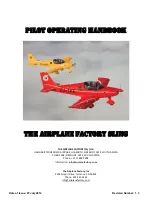
28
10.6 In Air Engine Fire
For fire occurring whilst in flight, the initial procedure would be to maintain control of the ultralight and
evaluate the extent of the fire. This emergency is unlikely to occur but to avoid any further problems, use
common sense and land the ultralight safely. Proceed as follows:
Maintain Control
Ignition off
Forced Landing
After landing release seat belt
Evacuate ultralight.
10.7 On Ground Engine Fire
If fire occurring whilst on the ground proceed as follows:
Maintain control and use remaining speed to clear people, others ultralights and buildings.
Close the throttle.
Turn the ignition off.
After stopping release seat belt.
Evacuate the ultralight.
10.8 Propeller Damage
The indication of propeller damage is usually felt by extreme vibration and lack of thrust. Proceed as
follows:
Maintain Control and airspeed.
Close the throttle.
Turn the ignition off.
Prepare for forced landing.
This problem may be avoided if precautions are taken prior to take off. Inspect the airstrip or ground you
are going to use as your take off area for sticks, rocks or any debris that may be flicked up by the tires
and sucked through the propeller.
Ensure that all items carried on board (such as cameras and sunglasses) are secured so they are
not able to come loose and pass through the propeller.
WARNING
AT FULL ENGINE RPM THE TIP OF THE PROPELLER IS SPINNING AT SPEEDS IN EXCESS OF 650
KILOMETERS PER HOUR.
EVEN SMALL OBJECTS CAN CAUSE SIGNIFICANT DAMAGE TO THE PROPELLER.
10.9 Sail Damage
If you encounter damage to the sailcloth during flight, the first procedure is to maintain control of the
ultralight. If the sail damage is not changing the flight characteristics of the ultralight, land at the nearest
landing field to inspect the damage.
10.10 Emergency Rescue System
The Comelli Cylindricone ballistic rescue system may be installed on the ANT trike.
The rescue system is equipped with a pressure gauge to check the charge of the cylinder before each
flight. The reading of the pressure gauge must be between 120 and 180 bar.
The emergency rescue system is only to be used in emergency situations as a last resort and when you
are certain that:
· the ultralight has suffered structural damage to the extent that control is not possible; or
· if the ultralight is in an irrecoverable situation where structural damage is likely to occur.
To operate the parachute pull the handle at least twenty centimetres for the parachute rocket projectile
to be activated. The parachute will allow the complete ultralight to be lowered to the ground. The
emergency system will automatically kill the engine after deployment.
Summary of Contents for ANT
Page 2: ...2...







































